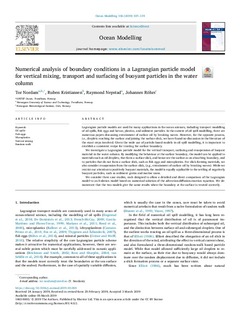Numerical analysis of boundary conditions in a Lagrangian particle model for vertical mixing, transport and surfacing of buoyant particles in the water column
| dc.contributor.author | Nordam, Tor | |
| dc.contributor.author | Kristiansen, Ruben | |
| dc.contributor.author | Nepstad, Raymond | |
| dc.contributor.author | Röhrs, Johannes | |
| dc.date.accessioned | 2019-05-24T13:06:05Z | |
| dc.date.available | 2019-05-24T13:06:05Z | |
| dc.date.created | 2019-05-22T14:09:15Z | |
| dc.date.issued | 2019-04 | |
| dc.identifier.citation | Ocean Modelling. 2019, 136 107-119. | nb_NO |
| dc.identifier.issn | 1463-5003 | |
| dc.identifier.uri | http://hdl.handle.net/11250/2598693 | |
| dc.description.abstract | Lagrangian particle models are used for many applications in the ocean sciences, including transport modelling of oil spills, fish eggs and larvae, plastics, and sediment particles. In the context of oil spill modelling, there are numerous papers discussing entrainment of surface oil by breaking waves. However, for the opposite process, i.e., droplets reaching the surface and joining the surface slick, we have found no discussion in the literature of the exact steps involved. Given the wide use of particle-based models in oil spill modelling, it is important to establish a consistent recipe for treating the surface boundary. We investigate a Lagrangian particle model for the vertical transport, surfacing and resuspension of buoyant material in the water column. By modifying the behaviour at the surface boundary, the model can be applied to materials such as oil droplets, that form a surface slick, and hence see the surface as an absorbing boundary, and to particles that do not form a surface slick, such as fish eggs and microplastics. For slick-forming materials, we also consider resuspension from the surface slick, (e.g., entrainment of surface oil by breaking waves). While we restrict our attention to positively buoyant materials, the model is equally applicable to the settling of negatively buoyant particles, such as sediment grains and marine snow. We consider three case studies, each designed to allow a detailed and direct comparison of the Lagrangian model to an Eulerian model based on numerical solution of the advection-diffusion-reaction equation. We demonstrate that the two models give the same results when the boundary at the surface is treated correctly. | nb_NO |
| dc.description.abstract | Numerical analysis of boundary conditions in a Lagrangian particle model for vertical mixing, transport and surfacing of buoyant particles in the water column | nb_NO |
| dc.language.iso | eng | nb_NO |
| dc.publisher | Elsevier | nb_NO |
| dc.rights | Navngivelse 4.0 Internasjonal | * |
| dc.rights.uri | http://creativecommons.org/licenses/by/4.0/deed.no | * |
| dc.subject | Oil spills | nb_NO |
| dc.subject | Fish eggs | nb_NO |
| dc.subject | Microplastics | nb_NO |
| dc.subject | Vertical mixing | nb_NO |
| dc.subject | Random walk | nb_NO |
| dc.title | Numerical analysis of boundary conditions in a Lagrangian particle model for vertical mixing, transport and surfacing of buoyant particles in the water column | nb_NO |
| dc.type | Journal article | nb_NO |
| dc.type | Peer reviewed | nb_NO |
| dc.description.version | publishedVersion | nb_NO |
| dc.source.pagenumber | 107-119 | nb_NO |
| dc.source.volume | 136 | nb_NO |
| dc.source.journal | Ocean Modelling | nb_NO |
| dc.identifier.doi | 10.1016/j.ocemod.2019.03.003 | |
| dc.identifier.cristin | 1699524 | |
| cristin.unitcode | 7566,6,0,0 | |
| cristin.unitname | Miljø og nye ressurser | |
| cristin.ispublished | true | |
| cristin.fulltext | original | |
| cristin.qualitycode | 1 |
Files in this item
This item appears in the following Collection(s)
-
Publikasjoner fra CRIStin - SINTEF Ocean [1369]
-
SINTEF Ocean [1443]

